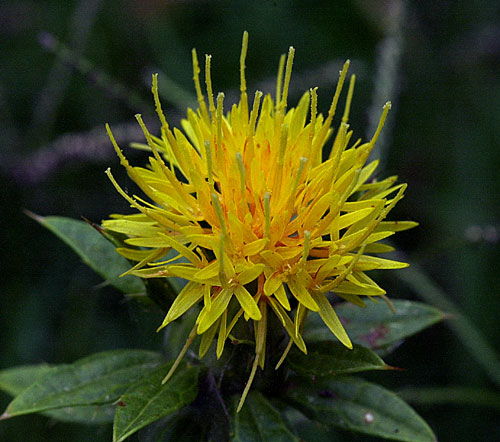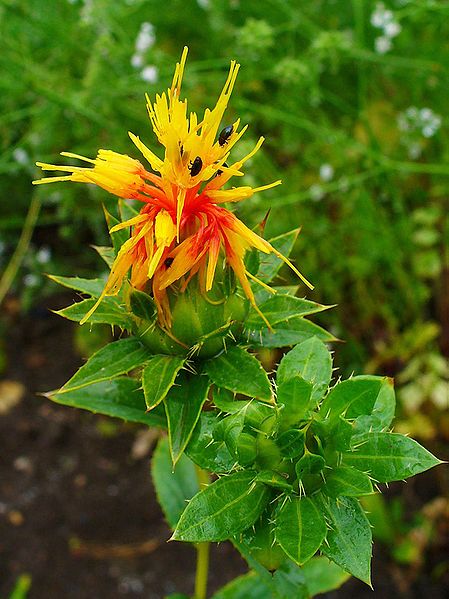紅花--Safflower
發表於 : 週二 8月 03, 2010 12:26 pm
紅花
科: 菊科 Asteraceae
屬: 紅花屬 Carthamus
Carthamus tinctorius
日本語: ベニバナ--紅花---末摘花--すえつむはな
日本山形縣花
Safflower
http://zh.wikipedia.org/zh-tw/File:Safflower.jpg

http://zh.wikipedia.org/zh-tw/%E7%BA%A2%E8%8A%B1
紅花(學名:Carthamus tinctorius),又稱紅藍、黃藍,菊科紅花屬。這種花不宜與番紅花相混淆。
一年或二年生草本植物,高可達90厘米。葉為卵形或卵狀披針形。頭狀花序頂生,兩性,花初開為黃色,後轉為橘紅色。花晒乾之後可作紅色染料或胭脂。
紅花古稱「煙支」、「燕支」、「胭脂」等,原產於西域。匈奴人認為妻妾如紅花般可愛,因此稱之為閼氏。古時煙支山(今甘肅省永昌縣、山丹縣之間)盛產紅花,漢武帝時大將霍去病奪下曾為匈奴佔領的煙支山,使匈奴人「婦女無顏色」[1]。
春季初生的紅花幼苗可作蔬菜食用,稱之為「紅花菜」。種子可榨油。花晒乾可作藥用,稱為「紅藍花」。
http://en.wikipedia.org/wiki/Safflower
Uses
Traditionally, the crop was grown for its seeds, and used for colouring and flavouring foods, in medicines, and making red (carthamin) and yellow dyes, especially before cheaper aniline dyes became available.[2] For the last fifty years or so, the plant has been cultivated mainly for the vegetable oil extracted from its seeds. In April 2007 it was reported that genetically modified safflower has been bred to create insulin.[3]
Safflower oil is flavorless and colorless, and nutritionally similar to sunflower oil. It is used mainly in cosmetics and as a cooking oil, in salad dressing, and for the production of margarine. It may also be taken as a nutritional supplement. INCI nomenclature is Carthamus tinctorius.
Safflower flowers are occasionally used in cooking as a cheaper substitute for saffron, and are thus sometimes referred to as "bastard saffron." Safflower seed is also used quite commonly as an alternative to sunflower seed in birdfeeders, as squirrels do not like the taste of it.
The pharmaceutical company SemBioSys Genetics is currently using transgenic safflower plants to produce human insulin as the global demand for the hormone grows. Safflower-derived human insulin is currently in the PI/II trials on human test subjects. Phillip Stephan, SemBioSys Genetics Inc, product bulletin June 2008.[4]
There are two types of safflower that produce different kinds of oil: one high in monounsaturated fatty acid (oleic acid) and the other high in polyunsaturated fatty acid (linoleic acid). Currently the predominant oil market is for the former, which is lower in saturates than olive oil, for example.
Safflower oil is also used in painting in the place of linseed oil, particularly with white, as it does not have the yellow tint which linseed oil possesses.
Lana is a strain of Safflower that grows in the southwestern United States, most notably Arizona and New Mexico.
In colouring textiles, safflower's dried flowers are used as a natural textile dye. Natural dyes derived from plants are not widely used in industry but it is getting more important world wide because of naturality and fashion trends. The colourful matter in safflower is benzoquinone-based Carthamin, so it is one of the quinone type natural dyes. It is a direct dye (CI Natural Red 26) and soluble. Yellow, mustard, khaki, olive green or even red colours can be obtained on textiles, but it is mostly used for yellow colours. All hydrophilic fibres (all natural fibres, such as cotton, wool, etc.) can be dyed with this plant since it can be classified as a direct dye. Polyamide can also be dyed without a mordant agent because of its wool-like chemical structure. Polyester, polyacrylnitryl and others which are hydrophobic synthetic fibres can be dyed only in the existence of a mordant.
Safflower concentrate is an ingredient of the carbonated soft drinks Tizer.
History
Safflower is one of humanity's oldest crops. Chemical analysis of ancient Egyptian textiles dated to the Twelfth dynasty identified dyes made from safflower, and garlands made from safflowers were found in the tomb of the pharaoh Tutankhamun.[5] John Chadwick reports that the Greek name for safflower occurs many times in Linear B tablets, distinguished into two kinds: a white safflower, which is measured, and red which is weighed. "The explanation is that there are two parts of the plant which can be used; the pale seeds and the red florets."[6]
Safflower was also known as carthamine in the 19th century.[7] It is a minor crop today, with about 600,000 tons being produced commercially in more than sixty countries worldwide. India, United States, and Mexico are the leading producers, with Ethiopia, Kazakhstan, China, Argentina and Australia accounting for most of the remainder.
Other names include Sallflower, Beni, Chimichanga, or Carthamus Tinctorius.
Tuerkischer safran
代替昂貴的番紅花
http://en.wikipedia.org/wiki/File:Tuerk ... safran.jpg

Okegawa Safflower Field 埼玉県桶川市加納
http://ja.wikipedia.org/wiki/%E3%83%95% ... ield_1.JPG

日文
紅花寫真
http://www.hana300.com/benina.html
紅花資料館公式網
http://www.town.kahoku.yamagata.jp/beni/index.html
紅花栽培
http://www.atariya.net/hana/beniba.htm
末摘花
光源氏與常陸介國守親王之女的故事
http://zh.wikipedia.org/zh-tw/%E6%9C%AB ... 8%E8%8A%B1
圖檔
http://commons.wikimedia.org/wiki/Carth ... lang=zh-tw
http://commons.wikimedia.org/wiki/File: ... us_002.JPG

動畫
http://disney-studio.jp/ghibli/product/?cid=236
http://ja.wikipedia.org/wiki/%E3%81%8A% ... D%E3%82%8D
http://zh.wikipedia.org/zh-tw/%E5%84%BF ... 4%E6%BB%B4
《兒時的點點滴滴》(日文:おもひでぽろぽろ,意為「記憶的點點滴滴」)為1991年由吉卜力工作室推出的動畫長片。根據岡本螢、刀根夕子的漫畫原作改編,宮崎駿為監製,高畑勳擔任導演與編劇。
角色介紹
岡島妙子(岡島タエ子)
27歲,東京上班一族,受周遭人歡迎。1982年的夏天向公司請了10天假去山形縣鄉村旅行,順道體驗鄉土生活。在農莊生活的日子,妙子辛勞地採集染布用的紅花。愛上了自然恬靜的生活之餘,不時回憶起小學五年級的自己和點滴。
岡島妙子(岡島タエ子) (五年級生)
11歲,就讀男女合校小學,為人任性、偏食 (不吃蘿蔔絲、洋蔥)、對數字遲鈍 (尤其分數除法),擅長作文。在繪畫和演戲方面有潛質,有機會當文藝節話劇的童角,並有大學劇團想邀請演出。
敏雄(トシオ)
25歲,妙子大姐夫的堂弟,為人開朗親切、辨事認真,是名熱心的年輕農夫。大清早在妙子到達的高瀨車站接她,並當她的嚮導,讓她體會了整個農家生活的氣氛。俊雄在別離前一晚,替妙子解開兒時以來一直耿耿於懷的「我不會和你握手。」之謎。
奈奈子(ナナ子)
妙子大姐,上班族,愛美麗,喜歡走在潮流尖端。
彌惠子(ヤエ子)
妙子二姐,高才生,漂亮但為人高傲,不時戲弄小時候的妙子。
谷常子(谷ツネ子)
妙子小學時的同班同學。
愛子(アイ子)
配音演員
日文版
岡島タエ子 (Taeko):今井美樹
タエ子 (五年級生時):本名陽子
トシオ (Toshio):柳葉敏郎
片尾曲
都はるみ演唱
http://www.youtube.com/watch?v=-tB3a7DuidE
愛は花、君はその種子
原詞作詞 /Amanda McBroom
日本語訳詞/高畑 勲
作曲 /Amanda McBroom
曲名 愛は花、君はその種子
歌詞
やさしさを 押し流す
愛 それは川
魂を 切り裂く
愛 それはナイフ
とめどない 渇きが
愛だと いうけれど
愛は花 生命の花
きみは その種子
挫けるのを 恐れて
躍らない きみのこころ
醒めるのを 恐れて
チャンス逃す きみの夢
奪われるのが 嫌さに
与えない こころ
死ぬのを 恐れて
生きることができない
長い夜 ただひとり
遠い道 ただひとり
愛なんて 来やしない
そう おもうときには
思いだしてごらん 冬
雪に 埋もれていても
種子は春 おひさまの
愛で 花ひらく
http://www.youtube.com/watch?v=DY2vmrn1 ... re=related
原曲
The_Rose
http://en.wikipedia.org/wiki/The_Rose_(song)
http://www.youtube.com/watch?v=CB4EgdpY ... re=related
The Rose (song)
by Bette Midler
歌詞
Some say love it is a river
That drowns the tender reed
Some say love it is a razor
That leaves your soul to bleed
Some say love it is a hunger
And endless aching need
I say love it is a flower
And you its only seed
It's the heart afraid of breaking
That never learns to dance
It's the dream afraid of waking
That never takes the chance 才
It's the one who won't be taken
Who can not seem to give
And the soul afraid of dying
That never learns to live
When the night has been too lonely
And the road has been too long
And you think that love is only
For the lucky and the strong
Just remember in the winter
Far beneath the bitter snow
Lies the seed that with the sun's love
In the spring becomes the rose
科: 菊科 Asteraceae
屬: 紅花屬 Carthamus
Carthamus tinctorius
日本語: ベニバナ--紅花---末摘花--すえつむはな
日本山形縣花
Safflower
http://zh.wikipedia.org/zh-tw/File:Safflower.jpg

http://zh.wikipedia.org/zh-tw/%E7%BA%A2%E8%8A%B1
紅花(學名:Carthamus tinctorius),又稱紅藍、黃藍,菊科紅花屬。這種花不宜與番紅花相混淆。
一年或二年生草本植物,高可達90厘米。葉為卵形或卵狀披針形。頭狀花序頂生,兩性,花初開為黃色,後轉為橘紅色。花晒乾之後可作紅色染料或胭脂。
紅花古稱「煙支」、「燕支」、「胭脂」等,原產於西域。匈奴人認為妻妾如紅花般可愛,因此稱之為閼氏。古時煙支山(今甘肅省永昌縣、山丹縣之間)盛產紅花,漢武帝時大將霍去病奪下曾為匈奴佔領的煙支山,使匈奴人「婦女無顏色」[1]。
春季初生的紅花幼苗可作蔬菜食用,稱之為「紅花菜」。種子可榨油。花晒乾可作藥用,稱為「紅藍花」。
http://en.wikipedia.org/wiki/Safflower
Uses
Traditionally, the crop was grown for its seeds, and used for colouring and flavouring foods, in medicines, and making red (carthamin) and yellow dyes, especially before cheaper aniline dyes became available.[2] For the last fifty years or so, the plant has been cultivated mainly for the vegetable oil extracted from its seeds. In April 2007 it was reported that genetically modified safflower has been bred to create insulin.[3]
Safflower oil is flavorless and colorless, and nutritionally similar to sunflower oil. It is used mainly in cosmetics and as a cooking oil, in salad dressing, and for the production of margarine. It may also be taken as a nutritional supplement. INCI nomenclature is Carthamus tinctorius.
Safflower flowers are occasionally used in cooking as a cheaper substitute for saffron, and are thus sometimes referred to as "bastard saffron." Safflower seed is also used quite commonly as an alternative to sunflower seed in birdfeeders, as squirrels do not like the taste of it.
The pharmaceutical company SemBioSys Genetics is currently using transgenic safflower plants to produce human insulin as the global demand for the hormone grows. Safflower-derived human insulin is currently in the PI/II trials on human test subjects. Phillip Stephan, SemBioSys Genetics Inc, product bulletin June 2008.[4]
There are two types of safflower that produce different kinds of oil: one high in monounsaturated fatty acid (oleic acid) and the other high in polyunsaturated fatty acid (linoleic acid). Currently the predominant oil market is for the former, which is lower in saturates than olive oil, for example.
Safflower oil is also used in painting in the place of linseed oil, particularly with white, as it does not have the yellow tint which linseed oil possesses.
Lana is a strain of Safflower that grows in the southwestern United States, most notably Arizona and New Mexico.
In colouring textiles, safflower's dried flowers are used as a natural textile dye. Natural dyes derived from plants are not widely used in industry but it is getting more important world wide because of naturality and fashion trends. The colourful matter in safflower is benzoquinone-based Carthamin, so it is one of the quinone type natural dyes. It is a direct dye (CI Natural Red 26) and soluble. Yellow, mustard, khaki, olive green or even red colours can be obtained on textiles, but it is mostly used for yellow colours. All hydrophilic fibres (all natural fibres, such as cotton, wool, etc.) can be dyed with this plant since it can be classified as a direct dye. Polyamide can also be dyed without a mordant agent because of its wool-like chemical structure. Polyester, polyacrylnitryl and others which are hydrophobic synthetic fibres can be dyed only in the existence of a mordant.
Safflower concentrate is an ingredient of the carbonated soft drinks Tizer.
History
Safflower is one of humanity's oldest crops. Chemical analysis of ancient Egyptian textiles dated to the Twelfth dynasty identified dyes made from safflower, and garlands made from safflowers were found in the tomb of the pharaoh Tutankhamun.[5] John Chadwick reports that the Greek name for safflower occurs many times in Linear B tablets, distinguished into two kinds: a white safflower, which is measured, and red which is weighed. "The explanation is that there are two parts of the plant which can be used; the pale seeds and the red florets."[6]
Safflower was also known as carthamine in the 19th century.[7] It is a minor crop today, with about 600,000 tons being produced commercially in more than sixty countries worldwide. India, United States, and Mexico are the leading producers, with Ethiopia, Kazakhstan, China, Argentina and Australia accounting for most of the remainder.
Other names include Sallflower, Beni, Chimichanga, or Carthamus Tinctorius.
Tuerkischer safran
代替昂貴的番紅花
http://en.wikipedia.org/wiki/File:Tuerk ... safran.jpg

Okegawa Safflower Field 埼玉県桶川市加納
http://ja.wikipedia.org/wiki/%E3%83%95% ... ield_1.JPG

日文
紅花寫真
http://www.hana300.com/benina.html
紅花資料館公式網
http://www.town.kahoku.yamagata.jp/beni/index.html
紅花栽培
http://www.atariya.net/hana/beniba.htm
末摘花
光源氏與常陸介國守親王之女的故事
http://zh.wikipedia.org/zh-tw/%E6%9C%AB ... 8%E8%8A%B1
圖檔
http://commons.wikimedia.org/wiki/Carth ... lang=zh-tw
http://commons.wikimedia.org/wiki/File: ... us_002.JPG

動畫
http://disney-studio.jp/ghibli/product/?cid=236
http://ja.wikipedia.org/wiki/%E3%81%8A% ... D%E3%82%8D
http://zh.wikipedia.org/zh-tw/%E5%84%BF ... 4%E6%BB%B4
《兒時的點點滴滴》(日文:おもひでぽろぽろ,意為「記憶的點點滴滴」)為1991年由吉卜力工作室推出的動畫長片。根據岡本螢、刀根夕子的漫畫原作改編,宮崎駿為監製,高畑勳擔任導演與編劇。
角色介紹
岡島妙子(岡島タエ子)
27歲,東京上班一族,受周遭人歡迎。1982年的夏天向公司請了10天假去山形縣鄉村旅行,順道體驗鄉土生活。在農莊生活的日子,妙子辛勞地採集染布用的紅花。愛上了自然恬靜的生活之餘,不時回憶起小學五年級的自己和點滴。
岡島妙子(岡島タエ子) (五年級生)
11歲,就讀男女合校小學,為人任性、偏食 (不吃蘿蔔絲、洋蔥)、對數字遲鈍 (尤其分數除法),擅長作文。在繪畫和演戲方面有潛質,有機會當文藝節話劇的童角,並有大學劇團想邀請演出。
敏雄(トシオ)
25歲,妙子大姐夫的堂弟,為人開朗親切、辨事認真,是名熱心的年輕農夫。大清早在妙子到達的高瀨車站接她,並當她的嚮導,讓她體會了整個農家生活的氣氛。俊雄在別離前一晚,替妙子解開兒時以來一直耿耿於懷的「我不會和你握手。」之謎。
奈奈子(ナナ子)
妙子大姐,上班族,愛美麗,喜歡走在潮流尖端。
彌惠子(ヤエ子)
妙子二姐,高才生,漂亮但為人高傲,不時戲弄小時候的妙子。
谷常子(谷ツネ子)
妙子小學時的同班同學。
愛子(アイ子)
配音演員
日文版
岡島タエ子 (Taeko):今井美樹
タエ子 (五年級生時):本名陽子
トシオ (Toshio):柳葉敏郎
片尾曲
都はるみ演唱
http://www.youtube.com/watch?v=-tB3a7DuidE
愛は花、君はその種子
原詞作詞 /Amanda McBroom
日本語訳詞/高畑 勲
作曲 /Amanda McBroom
曲名 愛は花、君はその種子
歌詞
やさしさを 押し流す
愛 それは川
魂を 切り裂く
愛 それはナイフ
とめどない 渇きが
愛だと いうけれど
愛は花 生命の花
きみは その種子
挫けるのを 恐れて
躍らない きみのこころ
醒めるのを 恐れて
チャンス逃す きみの夢
奪われるのが 嫌さに
与えない こころ
死ぬのを 恐れて
生きることができない
長い夜 ただひとり
遠い道 ただひとり
愛なんて 来やしない
そう おもうときには
思いだしてごらん 冬
雪に 埋もれていても
種子は春 おひさまの
愛で 花ひらく
http://www.youtube.com/watch?v=DY2vmrn1 ... re=related
原曲
The_Rose
http://en.wikipedia.org/wiki/The_Rose_(song)
http://www.youtube.com/watch?v=CB4EgdpY ... re=related
The Rose (song)
by Bette Midler
歌詞
Some say love it is a river
That drowns the tender reed
Some say love it is a razor
That leaves your soul to bleed
Some say love it is a hunger
And endless aching need
I say love it is a flower
And you its only seed
It's the heart afraid of breaking
That never learns to dance
It's the dream afraid of waking
That never takes the chance 才
It's the one who won't be taken
Who can not seem to give
And the soul afraid of dying
That never learns to live
When the night has been too lonely
And the road has been too long
And you think that love is only
For the lucky and the strong
Just remember in the winter
Far beneath the bitter snow
Lies the seed that with the sun's love
In the spring becomes the rose